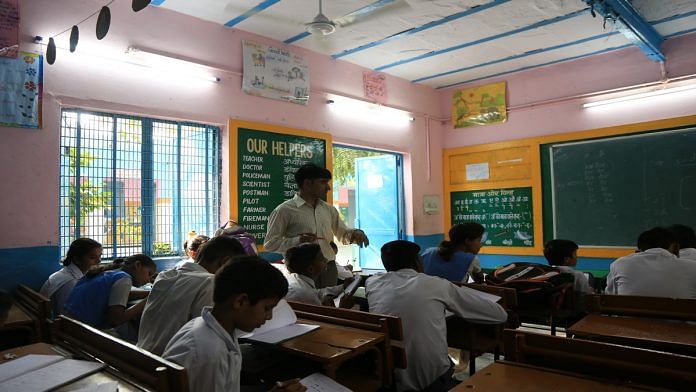Over the last four years, Himachal Pradesh’s board pass percentage had been steadily declining. But this year, Himachal Pradesh managed to reverse the trend for both Class 10 and 12. The pass percentage for Class 10 is now 68.11 per cent, a 7.32 percentage point increase from 60.79 per cent last year, while the pass percentage for Class 12 rose by 14.06 percentage points to 76.07 per cent from 62.01 per cent last year.
The reason for the decline was this: Himachal Pradesh never had a system to benchmark and analyse board results, students’ performance, schools and subjects. This was needed to chalk out corrective action.
Internal assessments were not digitised for analysing and identifying weaker classes, schools or subjects. The coordination between key entities such as Samagra Shiksha(SS), State Council of Educational Research and Training (SCERT) and Department of Higher Education (DHE), with respect to board exam preparation, was limited. Historically, the political leadership and district administrations had not developed a common vision of improving board results in the state.
Government-led campaign
Starting in August 2019, the government of Himachal Pradesh undertook various targeted measures to improve the pass percentage. The state’s education minister, Suresh Bharadwaj, became the voice and face of the holistic campaign centred on board result improvement. This was critical because only when the state’s leadership spearheads such a campaign does the message percolate down to the entire ecosystem, including parents of students. Bharadwaj set a quantifiable and aspirational target for the state — increasing the Class 10 and 12 pass percentage to 80 per cent in the 2020 board exams. Bharadwaj also chaired a meeting with all District Collectors (DC) through video conference to get them on board and focus on exam preparation within their districts.
Pre-board examinations
While pre-board exams are commonplace in private schools, December 2019 was the first time that all 2,777 government secondary schools in Himachal Pradesh conducted standardised pre-board exams for Classes 10 and 12. This was the cornerstone of the campaign because it gave students much-needed practice before the main exams. Poor performance in the pre-board exams brought alertness to the entire system.
Also read: Marks for cancelled CBSE Class 12, 10 exams to be based on students’ best performing subjects
Cross-departmental task force
The state department of education created a dedicated central taskforce to manage the campaign. Through multiple workshops, SS, SCERT and DHE managed the campaign and divided key responsibilities. The SCERT designed and printed the question papers, SS delivered them to schools across the state, while the DHE managed conduction of the pre-board examinations smoothly. This was unprecedented since these three bodies traditionally work in silos and do not collaborate on initiatives.
Using data to drive decisions
In the absence of an established system of pre-board assessment, teaching and learning efforts for board examinations were not informed by any concrete data. This year, pre-board assessment results were analysed, and insights at the state, district, block and school levels were made public through a dashboard. It included information such as the weakest subjects, the worst-performing schools, school ranking, comparison between districts, etc. These insights became the basis for performance improvement strategies developed by school principals which were then submitted to the education department. A total of 1.35 lakh remedial classes and 1.4 lakh practice tests were planned as part of these strategies across Himachal Pradesh.
Also read: Better data can improve public education in India – draft National Education Policy says it too
Involvement of district administration
The district collectors created local improvement plans based on pre-board results and held their officials and schools accountable for implementation of these plans. In many districts, DCs held meetings with principals of the worst-performing schools to discern any challenges they may be facing and to mandate a minimum number of extra classes and mock tests.
In Sirmaur district, teacher vacancies were managed by deputing middle school teachers to secondary schools to conduct remedial classes. Chamba and Kangra districts went one step further and conducted a second set of district-level pre-board exams to further improve preparation. The DC of Lahaul and Spiti airlifted question papers for the exam from Solan and ensured their delivery to all schools in the remotest regions of the district. The DC of Kinnaur arranged for heating equipment in schools to ensure the comfort of students.
Improving access to resources
To aid in the preparation for the final exams, relevant academic resources were made available to teachers and students. Resources such as previous years’ question papers, question banks for the weakest subjects, topic-wise marks distribution for the board papers, tips for students on managing time during the final exam and subject-specific scoring tips were provided to students through a dedicated website. Printed copies of the same were also distributed.
Also read: Indian children are schooling, not learning. Modi govt must fix it with national edu policy
Review and monitoring
For a campaign of this scale to succeed, it was necessary to establish a robust review and monitoring mechanism to track and accelerate progress. Education department officials in Himachal Pradesh made regular visits to schools to monitor, mentor and motivate teachers and students.
Data on compliance of each school against the targeted number of extra classes and practice tests was recorded and published on the pre-boards website. A cascading model of reviews was set up to take quick action on the findings of these visits. While district officials reviewed progress weekly, the education department’s senior leadership conducted fortnightly reviews to monitor the progress districts made. Nearly 80 per cent of the schools visited were compliant with their improvement plans.
In the end, it took months of preparation, planning and the sustained efforts of the administration, teachers and students for Himachal Pradesh to significantly improve its performance in the board exams.
Ankur Bansal is Co-Founder and Pragya Mathur is Associate at Samagra | Transforming Governance, a mission-driven governance consulting firm. Views are personal.



